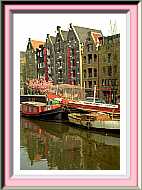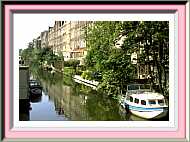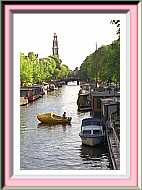from social-renting
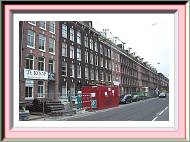
with on the back side the
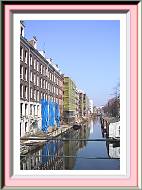
socalled 'Jordaan oever'
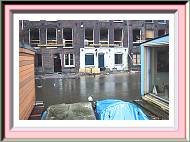
|
Social rental apartments are disappearing also in an other way.
When buildings are not maintained for a long time, than total renovation will be necessary.
And if the existing façades remain intact, the city service departments are satisfied.
The tenants will then be marked as socalled urban renewal urgents by the Amsterdam housing department.
This put them on top of the list of rental apartments and let them choose from the crème de la crème
of the Amsterdam rental houses.
The tenant also receives some thousands of euro's as compensation in moving costs.
After that the properties are renovated and sold for a large sum to non-Amsterdammers and
older ex-Amsterdammers who want to come back to the city.
Ex-owners, tenants, project developers, builders, new owners and the city council are satisfied.
The ordinary Amsterdammer however is twice victimised:
a large group of socalled urgents who go ahead on the waitinglist, plus a large block of social rental apartments
which disappears.
A good example is the Marnixstraat odd numbers from 121 and lower.
Besides, this block of houses lies in the neighbourhood council of Amsterdam-Centrum,
but outside the Jordaan; namely on the other side of the Lijnbaansgracht, the historical boundary of the Jordaan.
So, a project developer introduced the term Jordaan-oever (Jordaan-bank);
as an excuse for the Jordaan-priced apartments.
Even plans were made to break through the block of houses with a bicycle tunnel and a bridge,
as a continuation of the Palmgracht.
And that only to create a type of connection with the Jordaan so the project developers could ask higher prices
for their estate. This plan didn't go further.

By day there is the academic, gallery and atelier culture, with a choice in
restaurants and terrasses. Finished off by an outgoing student-like nightlife.
In the streets you see now his porsche or 4x4 for the impact and
her 3BigWheeler for the baby.
Furthermore, the dog is getting popular in the Jordaan Yuppie life.
There is little integration with the small number of original Jordanezen who stay behind
and whos families all have moved to the nearby town of Purmerend and Almere.
|
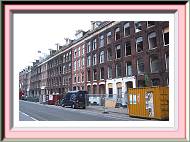
to free-sector-housing
literally
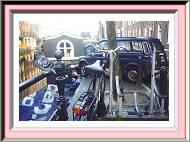
on the edge of the Jordaan
|
